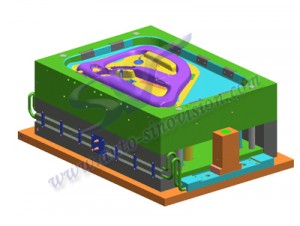Common injection mold materials are chemically and physically divided into acrylate, styrene and styrene. Each monomer has different characteristics: acrylate has high strength, thermal and chemical stability: from the morphological point of view, the polymerization of three monomers produces three-phase copolymer, which is divided into two stages: one is the continuous phase of styrene propylene diene, and the other is the dispersed phase of polybutylene rubber.
The performance of ABS mainly depends on the proportion of three monomers and the molecular structure of two phases. This allows great flexibility in product design and allows the production of hundreds of different quality injection and mold materials on the market. These injection molding and mold materials with different quality have different characteristics, such as high impact resistance, low fat and high finish, and high-temperature deformation characteristics. ABS injection molding, a mold material with high machinability, appearance characteristics, low creep, excellent dimensional stability and high impact strength. Water meters and other commercial equipment, cable sleeves, mechanical cams, sliding mechanisms and bearings. Car panel, tool cabin, wheel cover, mirror box, refrigerator, hair dryer, mixer, food processing machine, lawn mower, telephone booth, typewriter keyboard, golf cart, etc.

Process conditions of injection mold: it needs to be dried before processing. The recommended drying condition is 80~90 hours at least, and the material temperature should be lower than 0.1%. Melting temperature: 210~280c; Recommended temperature: 245 ℃. Mold temperature: 25~70C, mold temperature will affect the surface finish of plastic parts, while lower temperature will reduce the surface finish. Injection pressure: 500~1000bar. Injection speed: medium speed.
The injection mold design material ABS plastic technology combines the characteristics of three main components. Among them, Acrylonite has high hardness, high strength, heat resistance and corrosion resistance; Butadiene has impact resistance and toughness; Styrene has high luster, easy to color and process; The above analysis of the characteristics of three different components makes ABS injection mold structural materials develop into our “strong quality” and “rigid” comprehensive system performance of high toughness thermoplastics. Adjust the proportion of the three basic ingredients of ABS, and its performance will change accordingly to meet the requirements of various data applications of enterprises, such as high resistance ABS, heat resistant ABS, and high gloss ABS. The research of ABS injection mold production materials has a good processability, which can be formed by improving injection molding, extrusion, hot molding and other methods at the same time, or directly by sawing, drilling, filing, grinding and other methods. It can be mixed with organic solvents, and can also effectively control coating and surface information processing (such as electroplating) and treatment. ABS plastic is also an ideal choice for people who cannot replace wood and building construction materials. ABS injection mold related materials have certain high strength, light weight and high surface hardness It is smooth, easy to clean, dimensional stability, good creep resistance, and suitable for electroplating in China. Its application management work is still expanding. ABS plastics are widely used in Chinese industry. The quality of ABS injection molding products is usually used for electrical enclosures, boxes, parts, toys, etc.
Post time: Oct-21-2022

